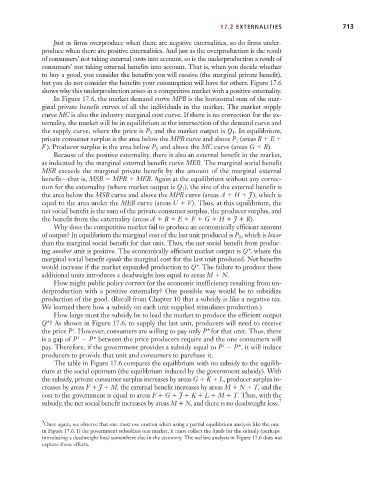Page 739 - Microeconomics, Fourth Edition
P. 739
c17ExternalitiesandPublicGoods.qxd 8/22/10 4:56 AM Page 713
17.2 EXTERNALITIES 713
Just as firms overproduce when there are negative externalities, so do firms under-
produce when there are positive externalities. And just as the overproduction is the result
of consumers’ not taking external costs into account, so is the underproduction a result of
consumers’ not taking external benefits into account. That is, when you decide whether
to buy a good, you consider the benefits you will receive (the marginal private benefit),
but you do not consider the benefits your consumption will have for others. Figure 17.6
shows why this underproduction arises in a competitive market with a positive externality.
In Figure 17.6, the market demand curve MPB is the horizontal sum of the mar-
ginal private benefit curves of all the individuals in the market. The market supply
curve MC is also the industry marginal cost curve. If there is no correction for the ex-
ternality, the market will be in equilibrium at the intersection of the demand curve and
the supply curve, where the price is P 1 and the market output is Q . In equilibrium,
1
private consumer surplus is the area below the MPB curve and above P (areas B E
1
F ). Producer surplus is the area below P and above the MC curve (areas G R).
1
Because of the positive externality, there is also an external benefit in the market,
as indicated by the marginal external benefit curve MEB. The marginal social benefit
MSB exceeds the marginal private benefit by the amount of the marginal external
benefit—that is, MSB MPB MEB. Again at the equilibrium without any correc-
tion for the externality (where market output is Q ), the size of the external benefit is
1
the area below the MSB curve and above the MPB curve (areas A H J ), which is
equal to the area under the MEB curve (areas U V). Thus, at this equilibrium, the
net social benefit is the sum of the private consumer surplus, the producer surplus, and
the benefit from the externality (areas A B E F G H J R).
Why does the competitive market fail to produce an economically efficient amount
of output? In equilibrium the marginal cost of the last unit produced is P , which is lower
1
than the marginal social benefit for that unit. Thus, the net social benefit from produc-
ing another unit is positive. The economically efficient market output is Q*, where the
marginal social benefit equals the marginal cost for the last unit produced. Net benefits
would increase if the market expanded production to Q*. The failure to produce these
additional units introduces a deadweight loss equal to areas M N.
How might public policy correct for the economic inefficiency resulting from un-
derproduction with a positive externality? One possible way would be to subsidize
production of the good. (Recall from Chapter 10 that a subsidy is like a negative tax.
We learned there how a subsidy on each unit supplied stimulates production.)
How large must the subsidy be to lead the market to produce the efficient output
Q*? As shown in Figure 17.6, to supply the last unit, producers will need to receive
s
the price P . However, consumers are willing to pay only P* for that unit. Thus, there
s
is a gap of P P* between the price producers require and the one consumers will
s
pay. Therefore, if the government provides a subsidy equal to P P*, it will induce
producers to provide that unit and consumers to purchase it.
The table in Figure 17.6 compares the equilibrium with no subsidy to the equilib-
rium at the social optimum (the equilibrium induced by the government subsidy). With
the subsidy, private consumer surplus increases by areas G K L, producer surplus in-
creases by areas F J M, the external benefit increases by areas M N T, and the
cost to the government is equal to areas F G J K L M T. Thus, with the
subsidy, the net social benefit increases by areas M N, and there is no deadweight loss. 7
7 Once again, we observe that one must use caution when using a partial equilibrium analysis like the one
in Figure 17.6. If the government subsidizes one market, it must collect the funds for the subsidy (perhaps
introducing a deadweight loss) somewhere else in the economy. The welfare analysis in Figure 17.6 does not
capture these effects.

